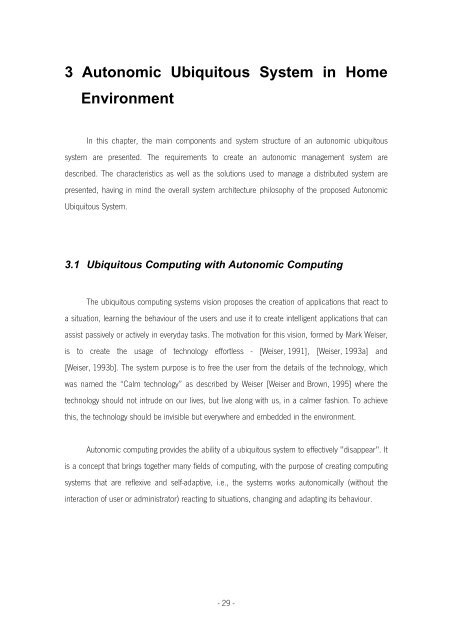Carlos Manuel Rodrigues Machado Autonomic Ubiquitous Computing
Carlos Manuel Rodrigues Machado Autonomic Ubiquitous Computing
Carlos Manuel Rodrigues Machado Autonomic Ubiquitous Computing
Sie wollen auch ein ePaper? Erhöhen Sie die Reichweite Ihrer Titel.
YUMPU macht aus Druck-PDFs automatisch weboptimierte ePaper, die Google liebt.
3 <strong>Autonomic</strong> <strong>Ubiquitous</strong> System in Home<br />
Environment<br />
In this chapter, the main components and system structure of an autonomic ubiquitous<br />
system are presented. The requirements to create an autonomic management system are<br />
described. The characteristics as well as the solutions used to manage a distributed system are<br />
presented, having in mind the overall system architecture philosophy of the proposed <strong>Autonomic</strong><br />
<strong>Ubiquitous</strong> System.<br />
3.1 <strong>Ubiquitous</strong> <strong>Computing</strong> with <strong>Autonomic</strong> <strong>Computing</strong><br />
The ubiquitous computing systems vision proposes the creation of applications that react to<br />
a situation, learning the behaviour of the users and use it to create intelligent applications that can<br />
assist passively or actively in everyday tasks. The motivation for this vision, formed by Mark Weiser,<br />
is to create the usage of technology effortless - [Weiser, 1991], [Weiser, 1993a] and<br />
[Weiser, 1993b]. The system purpose is to free the user from the details of the technology, which<br />
was named the “Calm technology” as described by Weiser [Weiser and Brown, 1995] where the<br />
technology should not intrude on our lives, but live along with us, in a calmer fashion. To achieve<br />
this, the technology should be invisible but everywhere and embedded in the environment.<br />
<strong>Autonomic</strong> computing provides the ability of a ubiquitous system to effectively "disappear". It<br />
is a concept that brings together many fields of computing, with the purpose of creating computing<br />
systems that are reflexive and self-adaptive, i.e., the systems works autonomically (without the<br />
interaction of user or administrator) reacting to situations, changing and adapting its behaviour.<br />
- 29 -

















